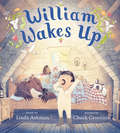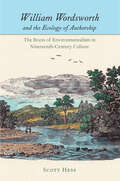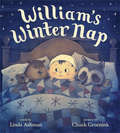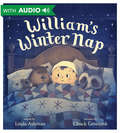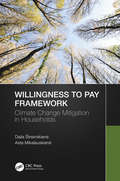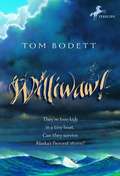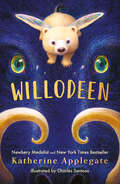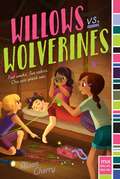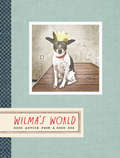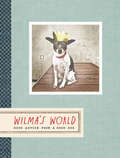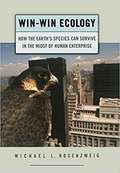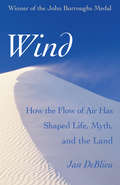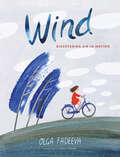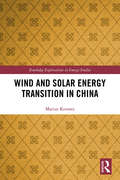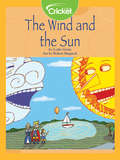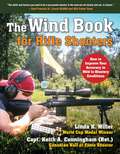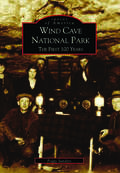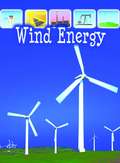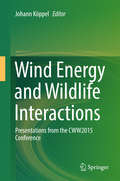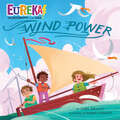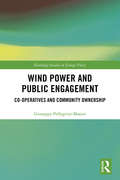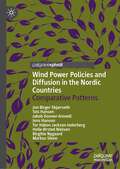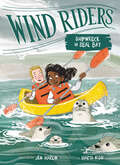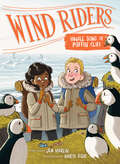- Table View
- List View
William Wakes Up (William)
by Linda AshmanWilliam and his animal friends have had the whole winter to nap. Now it's time for them to wake up and welcome a very special guest. There's lots to do to get ready, from scrubbing the floors to decorating the house to baking a tasty treat. But it's so hard to leave a cozy bed. . . . Will everyone get up in time to do their part?This book's gentle rhymes and humorous illustrations full of signs of spring will make it a little easier to wait for the first warm days of the season.
William Wordsworth and the Ecology of Authorship: The Roots of Environmentalism in Nineteenth-Century Culture (Under the Sign of Nature)
by Scott HessIn William Wordsworth and the Ecology of Authorship, Scott Hess explores Wordsworth’s defining role in establishing what he designates as "the ecology of authorship": a primarily middle-class, nineteenth-century conception of nature associated with aesthetics, high culture, individualism, and nation. Instead of viewing Wordsworth as an early ecologist, Hess places him within a context that is largely cultural and aesthetic. The supposedly universal Wordsworthian vision of nature, Hess argues, was in this sense specifically male, middle-class, professional, and culturally elite—factors that continue to shape the environmental movement today.
William's Winter Nap: An Ebook With Audio
by Linda AshmanJust when William is ready to fall asleep in his cozy cabin, there is a tap on his window. A chilly chipmunk asks to stay, and Will scooches over in bed. "There's room for two--I'm sure we'll fit." The chipmunk is just the first in a parade of mammals, each bigger than the last, until the bed is full. Then a note is slipped beneath the door: "Do you have room for just one more?" William tugs the door to see who's there . . . only to find a great big BEAR! Is there enough space to spare? Will the other animals be willing to share?Kids will delight at each new guest's arrival and enjoy counting along as the animals keep scooching over to fit in William's bed. Linda Ashman's clever rhymes set up each page turn with suspense and humor, and the expressions on Chuck Groenink's characters are perfect. This is must reading for the dark time of year when everyone wants to hibernate!
William's Winter Nap: An eBook with Audio
by Linda AshmanJust when William is ready to fall asleep in his cozy cabin, there is a tap on his window. A chilly chipmunk asks to stay, and Will scooches over in bed. "There's room for two--I'm sure we'll fit." The chipmunk is just the first in a parade of mammals, each bigger than the last, until the bed is full. Then a note is slipped beneath the door: "Do you have room for just one more?" William tugs the door to see who's there . . . only to find a great big BEAR! Is there enough space to spare? Will the other animals be willing to share?Kids will delight at each new guest's arrival and enjoy counting along as the animals keep scooching over to fit in William's bed. Linda Ashman's clever rhymes set up each page turn with suspense and humor, and the expressions on Chuck Groenink's characters are perfect. This is must reading for the dark time of year when everyone wants to hibernate!
Willingness to Pay Framework: Climate Change Mitigation in Households
by Dalia Štreimikienė Asta MikalauskienėThis book aims to develop a framework for the assessment of population ‘preferences in climate change mitigation policies by applying a Willingness to Pay (WTP) approach and presents the results from several case studies in Lithuania on renewable energy generation and renovation in different households. These analyses of climate change mitigation policies and measures, based on the assessment of their effectiveness, provide recommendations for developing innovative measures in other countries. Since public preferences are variable, climate change mitigation policies can change these preferences and allow to form new ones. Features: Analyses social benefits of climate change mitigation measures and their integration methods based on assessment of public preferences. Presents several practical case studies on energy needs where the Willingness to Pay framework was applied. Discusses climate change mitigation barriers in energy sector and the effectiveness of climate change mitigation policies to overcome them. Provides a novel approach for climate change mitigation policies development in households. Includes useful information for evaluating and planning policies related to renewable energy investment. This book is a useful reference for those in the academic, research, and business communities, policy makers, graduate students, and professionals involved with climate change mitigation projects.
Williwaw!
by Tom BodettFrom humorist, storyteller, author, and the voice of Motel 6 commercials, here is an exciting middle-grade adventure novel set in rural Alaska. <p><p> Ivan and September Crane, ages 12 and 13, are left alone for a couple of weeks while their fisherman Dad is away at sea. In typical adolescent fashion, they quickly proceed to ignore his only two instructions--don't run down the batteries on the portable short-wave radio, their only means of communication, and don't cross the bay to town. <p> Through a series of bad decisions they find themselves crossing Bag Bay in their skiff when they are suddenly overtaken by a sudden and fierce autumn storm known as a williwaw. Ivan and September must use every ounce of strength, courage, and ingenuity they posses to keep themselves afloat until help comes. <p> Williwaw contains rich descriptions of Alaskan geography and wildlife. Its likable characters and taut suspense will keep readers riveted until the last page.
Willodeen
by Katherine ApplegateThe earth is old and we are not, and that is all you must remember . . .Eleven-year-old Willodeen adores creatures of all kinds, but her favourites are the most unlovable beasts in the land: strange beasts known as 'screechers'. The villagers of Perchance call them pests, even monsters, but Willodeen believes the animals serve a vital role in the complicated web of nature.Lately, though, nature has seemed angry indeed. Perchance has been cursed with fires and mudslides, droughts and fevers, and even the annual migration of hummingbears, a source of local pride and income, has dwindled. For as long as anyone can remember, the tiny animals have overwintered in shimmering bubble nests perched atop blue willow trees, drawing tourists from far and wide. This year, however, not a single hummingbear has returned to Perchance, and no one knows why.When a handmade birthday gift brings unexpected magic to Willodeen and her new friend, Connor, she's determined to speak up for the animals she loves, and perhaps even uncover the answer to the mystery of the missing hummingbears.A timely and timeless tale about our fragile earth, and one girl's fierce determination to make a difference.
Willows vs. Wolverines
by Alison CherryIt’s an all-out boys vs. girls prank war in this hilarious summer camp novel from the author of The Classy Crooks Club!Izzy Cervantes and her best friend, Mackenzie, have spent summers together at Camp Sweetwater since they were eight. So when their parents decide to ship them off to Camp Foxtail instead, the girls find themselves completely out of their element—and worse yet, in different cabins! Izzy feels like an outsider in Willow Lodge. But when she hears about the time-honored prank war between the Willows and the Wolverines, the rival boy cabin, she sees a chance to make her mark. Convinced the girls will never accept her as one of them unless she has roots at Camp Foxtail, she boasts that her older brother is the most respected prankster in the camp’s history and would be happy to help them win the war. In reality, Izzy doesn’t even have an older brother, but the Willows embrace her as their new secret weapon, and Mackenzie agrees to help her hatch a series of epic stunts. As the hijinks escalate, so does Izzy’s popularity. But she becomes so focused on impressing her new friends that she starts neglecting Mackenzie, putting her friendship and her secret prank-master identity in serious jeopardy. Can Izzy keep the truth under wraps and win her best friend back, or will she end up on the wrong side of her allies as well as her enemies?
Wilma's World: Good Advice from a Good Dog
by Rae DunnWelcome to Wilma's World, where life is full of joy and adventure lies around every corner. This charming book of photographs celebrates the wise insights of a special dog whose musings remind us to slow down and see the beauty in simple things. Wilma's handmade style and playful personality will inspire adventurous spirits everywhere.
Wilma's World: Good Advice from a Good Dog
by Rae DunnWelcome to Wilma's World, where life is full of joy and adventure lies around every corner. This charming book of photographs celebrates the wise insights of a special dog whose musings remind us to slow down and see the beauty in simple things. Wilma's handmade style and playful personality will inspire adventurous spirits everywhere.
Win-Win Ecology: How the Earth's Species Can Survive In the Midst of Human Enterprise
by Michael L. RosenzweigAs humanity presses down inexorably on the natural world, people debate the extent to which we can save the Earth's millions of different species without sacrificing human economic welfare. But is this argument wise? Must the human and natural worlds be adversaries? In this book, ecologist Michael Rosenzweig finds that ecological science actually rejects such polarization. Instead it suggests that, to be successful, conservation must discover how we can blend a rich natural world into the world of economic activity. This revolutionary, common ground between development and conservation is called reconciliation ecology: creating and maintaining species-friendly habitats in the very places where people live, work, or play. The book offers many inspiring examples of the good results already achieved. The Nature Conservancy, for instance, has a cooperative agreement with the Department of Defense, with more than 200 conservation projects taking place on more than 170 bases in 41 states. In places such as Elgin Air Force Base, the human uses-testing munitions, profitable timbering and recreation--continue, but populations of several threatened species on the base, such as the long-leaf pine and the red-cockaded woodpecker, have been greatly improved. The Safe Harbor strategy of the Fish & Wildlife Service encourages private landowners to improve their property for endangered species, thus overcoming the unintended negative aspects of the Endangered Species Act. And Golden Gate Park, which began as a system of sand dunes, has become, through human effort, a world of ponds and shrubs, waterfowl and trees. Rosenzweig shows that reconciliation ecology is the missing tool of conservation, the practical, scientifically based approach that, when added to the rest, will solve the problem of preserving Earth's species.
Wind
by Jan DeblieuThe wind has sculpted Earth from the beginning of time, but it has also shaped humans--our histories, religions and cultures, the way we build our dwellings, and how we think and feel. In this poetic, acclaimed work, Jan DeBlieu takes the tempests of her home, the North Carolina Outer Banks, as a starting point for considering how the world's breezes and gales have made us who we are. She travels widely, seeking out the scientists, sailors and sages who, like her, are haunted by the movement of air.
Wind
by Olga FadeevaA browsable, appealing introduction to an important weather phenomenon.If your hair has ever blown back on a breezy day, you&’ve noticed the wind at work. But what causes the wind? Are there different types of wind? How do we measure and name them? How does the wind shape our ecosystems, plants, and animals? What about people: how have human beings used the wind in the past and the present? Can you really sail into the wind, and would a tailwind help or hurt your plane&’s takeoff? Up, up beyond the clouds, does the wind affect other planets, too? Created with help from a meteorologist, this beautiful book is a fascinating exploration of the wind&’s role in world history and earth science. Playful prose and colorful illustrations invite children to bring their questions along as they learn more about this powerful—but sometimes overlooked—natural element.
Wind and Solar Energy Transition in China (Routledge Explorations in Energy Studies)
by Marius KorsnesThis book explores the mobilisation of China’s wind and solar industries and examines the implications of this development to energy generation and distribution, innovation and governance. Unlike other publications that focus mainly on the formal policy landscape and statistics of industry development, this book delves deeper into the ways in which the wind and solar industries have evolved through negotiations made by the involved stakeholders, and how these industries play into larger Chinese development and policymaking interests. Overall, it sheds new light on the strategic development of China’s renewable energy industry, the flexible governance methods employed and the internal struggles which Chinese local, regional and central policymakers, and state-owned and private enterprises have faced. This book will be of great relevance to students and scholars of renewable energy technologies, energy policy and sustainability transitions, as well as policymakers with a specific interest in China.
The Wind and the Sun (Leveled Readers 2.6.3)
by Debbie O’BrienIn this fable, the Sun and the Wind have a contest.
The Wind Book for Rifle Shooters: How to Improve Your Accuracy in Mild to Blustery Conditions
by Linda K. Miller Keith A. CunninghamAll other factors being equal, it is your ability to read the wind that will make the most difference in your shooting accuracy. The better you understand the behavior of the wind, the better you will understand the behavior of your bullet. Now, champion shooters Linda K. Miller and Keith A. Cunningham reveal everything they wish they&’d known about reading the wind before they started shooting (instead of having to learn as they went along) in concise, easy-to-read terms and accompanied with handy ninety-five diagrams. The Wind Book for Rifle Shooters contains straightforward guidance on the simple thought process they use to read the wind, the techniques and tactics they use to win matches, and the underlying skills that support both. Let these champions show you how to put together a simple wind-reading toolbox for calculating wind speed, direction, deflection, and drift. Then learn how to use these tools to read flags and mirage, record and interpret your observations, and time your shots to compensate for wind. Other topics covered include: Analyzing shot placementRecording and record keepingConfidence and following your hunchesAnd much more!The essential wind-reading basics taught in this book will absolutely improve your shooting skills, whether you're a target shooter, a plinker, a hunter or a shooting professional.
Wind Cave National Park: The First 100 Years
by Peggy SandersWind Cave is one of the longest and most complex caves in the world. Complete with more than 100 miles of surveyed cavern passageways below ground and 28,295 acres of diverse ecology above, Wind Cave National Park is an American treasure with an impressive history. The first recorded discovery of Wind Cave occurred in 1881 when brothers Jesse and Tom Bingham followed the sounds of the whistling wind and came upon the cave. In 1903, the cave and surrounding area became Wind Cave National Park, the seventh national park in the nation and the first created with a cave as its focal point. In the 1930s, the Civilian Conservation Corps (CCC) established a camp near the park headquarters. The CCC built roads and buildings, landscaped and made improvements to better accommodate tours inside the cave.
Wind Energy (Let's Explore Global Energy)
by David Armentrout Patricia ArmentroutIntroduces methods of obtaining power from the wind, places wind power in context with other power resources, explains how it works, and considers the advantages and disadvantages of its possible future use.
Wind Energy and Wildlife Interactions
by Johann KöppelThis book presents a selection of new insights in understanding and mitigating impacts on wildlife and their habitats. Topics such as, species behaviour and responses; collision risk and fatality estimation; landscape features and gradients, are considered. Other chapters in the book cover the results of current research on mitigation; compensation; effectiveness of measures; monitoring and long-term effects; planning and siting. Examples are given of current research on shutdown on demand and curtailment algorithms. By identifying what we have learned so far, and which predominate uncertainties and gaps remain for future research, this book contributes to the most up to date knowledge on research and management options. This book includes presentations from the Conference on Wind Energy and Wildlife impacts (CWW15), March 2015, hosted by the Berlin Institute of Technology, which offered a platform to national and international participants to showcase the current state of knowledge in wind energy’s wildlife implications.
Wind Power (Eureka! The Biography of an Idea)
by Laura DriscollBlow, wind, blow! The newest addition to the nonfiction Eureka! series is a &“biography&” of wind power, which is green energy that can help the planet.People have harnessed the power of the wind for thousands of years, to travel by sailboat, to cool homes, to grind grain into flour, and even to make music. But when someone hooked a wind mill to a generator, wind went electric, unlocking the secret to a clean, renewable energy source! Wind Power is an entertaining and informative look at the development of an idea with huge benefits for a greener future. This STEAM nonfiction title is part of the Eureka! series, with each book focusing on one groundbreaking, world-changing discovery that millions of people use every single day.
Wind Power and Public Engagement: Co-operatives and Community Ownership (Routledge Studies in Energy Policy)
by Giuseppe Pellegrini-MasiniAdopting an interdisciplinary social science approach, this book examines community reactions to wind farms to form a new understanding of what facilitates social acceptance. Based on empirical research, Wind Power and Public Engagement investigates opposition to wind energy and considers the advantages as well as the limits of the co-operative model of wind farm community ownership. Giuseppe Pellegrini-Masini compares the role of co-operative schemes with community benefits schemes in increasing acceptability, and also sheds light on the impact of social factors including pro-environmental attitudes, perceived benefits and costs, place attachment, trust, as well as individuals’ resources such as information and income. Five research cases are investigated in England and Scotland, including the first local, community-owned wind farm co-operative in the UK. Critically reviewing existing social research theories, the book offers a new viewpoint, integrating rational choice and environmental attitudinal theories, from which to assess and understand the social acceptability of wind energy. It also highlights new opportunities for raising consensus in communities around locally proposed wind farms. The book will be of great interest to students and scholars of renewable energy, energy policy, environmental sociology, environmental psychology, environmental planning and sustainability in general, as well as policymakers.
Wind Power Policies and Diffusion in the Nordic Countries: Comparative Patterns
by Jon Birger Skjærseth Teis Hansen Jakob Donner-Amnell Jens Hanson Helle Ørsted Nielsen Birgitte Nygaard Markus Steen Tor Håkon InderbergThis book focuses specifically on policy mixes and wind power diffusion in four Nordic countries – Denmark, Finland, Norway and Sweden. Although these Nordic welfare states have much in common, they have adopted different wind power policies and experienced dissimilar diffusion trajectories. Understanding these patterns across the Nordic countries is the central puzzle that this book investigates. Empirically, this book provides a first-of-its-kind comparative study of wind power policies in the Nordic countries. Analytically, the authors contribute to the transition policy mix literature, which remains largely insensitive to political feasibility. This book will be of interest to researchers and students as well as private and public decision makers looking for tools to enable the energy transition.
Wind Riders #3: Shipwreck in Seal Bay (Wind Riders #3)
by Jen MarlinHop aboard Wind Rider, a magical sailboat, with Max and Sofia, two ordinary kids trying to save the environment one problem at a time. Their third mission? Saving harbor seals from an oil spill! You never know where Wind Rider will take you...Max and Sofia's summer vacation gets wild when they stumble upon an abandoned sailboat in the mangrove forest. They’re given the chance to make a real impact when the boat magically transports them to a different corner of the world to help other kids save their environment! Wind Riders: Shipwreck in Seal Bay is the third book in an illustrated adventure chapter book series. Each story visits a new location and introduces a human-made problem that's endangering animals and the environment. With nature’s highest stakes and environmental activism baked into each book, as well as fun scientific facts included at the end, Wind Riders is a great chapter book series for newly independent readers who love nature documentaries, taking action, and learning about the world around them. There is beautiful two-color art throughout and an emphasis on collaborative problem-solving, compassion for the Earth and all its inhabitants, and friendship. The books are printed on partially recycled paper. Wind Riders is the perfect STEM chapter book series for fans of Magic Tree House, The Magic School Bus, and Zoey and Sassafras.
Wind Riders #4: Whale Song of Puffin Cliff (Wind Riders #4)
by Jen MarlinJoin Max and Sofia, two kids trying to save the environment one problem at a time with their magical sailboat. Their latest mission? Cleaning up the plastic waste that's hurting puffins and belugas in Iceland.In Starry Bay, summer vacation means snorkeling for sea glass by the beach, until Max and Sofia come across an abandoned sailboat. With a spin of the wheel, Wind Rider transports them to animals who need their help! This time, they drop anchor in Iceland's frigid waters, where Max and Sofia team up with the Puffin Patrol, a group of Icelandic kids who protect and preserve the local puffin colony. But it seems that the puffins aren't the only ones in trouble. Max and Sofia will have to think fast to save a beached beluga whale.Wind Riders: Whale Song of Puffin Cliff is the fourth installment in this highly illustrated chapter book series. Each story visits a new location and introduces a human-made problem endangering animals and the environment.With nature’s highest stakes and environmental activism baked into each book, as well as fun scientific facts included at the end, Wind Riders promises to be the chapter book series for newly independent readers who love nature documentaries and are hungry to learn about the world around them.There is beautiful two-color art throughout and an emphasis on collaborative problem-solving, compassion for the Earth and all its inhabitants, and friendship. The books are printed on partially recycled paper. Wind Riders is the perfect STEM chapter book series for fans of Magic Tree House, The Magic School Bus, and Zoey and Sassafras.
